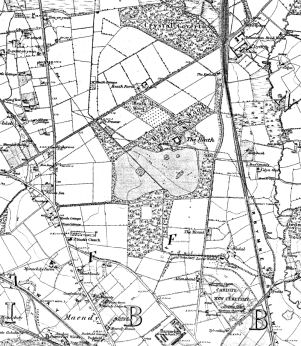THE HISTORY OF CARDIFF'S SUBURBS
HEATH

Source: Paul Vaccari
CONTENTS
Tap or click to open / closeSwampland
Until the 18th century, Heath was a large parcel of common land to the north of Cardiff, which was pitted with swamps, and covered by an extensive forest.
The Heath was actually two areas of land - 'Little Heath' covered much of Cathays and Roath whilst 'The Great Heath' extended as far as Llanishen and Rhiwbina.
Heath Racecourse
In the 1760s, part of the Great Heath became a racecourse which was two miles in length.
The Heath Enclosure Act of 1802 allowed the Cardiff Corporation to auction off the common land at Heath to raise revenue.
When the Great Heath was sold, the racecourse was retained, even though it was beginning to lose its appeal.
Source: OS
Rich, powerful families such as the Lewises were some of the main benefactors of the auction.
In return for cancelling a number of fairly small debts, the Corporation also transferred a proportion of its land to the Marquis of Bute at a bargain price.
The Enclosure Act transformed the Heath into an arable farming community, with Heath Farm, Allensbank Farm and Ton-yr-Ywen Farm all being created to tame and develop the land.
Much of the woodland was preserved and for more than a century, the district retained its rural aspect.
Heathfield House and Heath Park
Apart from the farms the only buildings in the district were a few cottages and Heathfield House, later known as ‘Heath House’.
This property was built by the Reverend W. Price Lewis in the mid 1840's, which added to the Lewis family's expansive estate on the Heath.
In 1938, the City Council purchased Heath House and associated parkland from a descendant of the Lewis family.
By the 1960s, most of the Heath was an urban suburb after the remainder of the lands owned by the Lewises and Butes were sold off for new housing developments.
Fortunately, Heath House and its grounds were the one area which was saved from the rapid expansion of housing, however the building had by now become derelict and eventually succumbed to arson in 1965.
The Park is bordered by King George V Drive, and is one of Cardiff’s finest facilities which over the years has served many purposes.
The Second World War
During World War 2, the park was initially used for military training, then by American forces making preparations for D-Day.
The Heath was badly hit during the War, when in May 1943, bombs fell in Allensbank Road, severely damaging the Heath Hotel and a row of houses, whilst in St Agnes Road, four houses were struck, resulting in nine people losing their life.
By 1946, Heath Park was the site for a temporary training college for teachers. Even after the Cardiff College of Education opened in Cyncoed, the temporary campus in the Heath was not closed until 1974.
Sixty years on, a few remaining wartime buildings are still used by the Local Authority.
University Hospital of Wales
A small part of Heath Park was lost forever when the University Hospital of Wales (referred to locally as "the Heath" or UHW), was constructed.
This major 1000-bed building was opened by the Queen in 1971, and is the 3rd largest hospital in the United Kingdom.
The hospital's location was chosen because of its proximity to Eastern and Northern Avenues, whose construction were nearing completion at the time.
In 2009, the BBC broadcast a documentary series filmed at the UHW called Hospital 24/7.
The intimidating Gabalfa interchange can be difficult to negotiate, and the main routes through the suburb are frequently clogged with rush hour traffic.
However; the large houses, nearby allotments, vicinity to Roath Park Lake, and the benefit of its own large park, makes Heath a very pleasant place in which to live and work.
PAGE UPDATE HISTORY
01 April 2024 (Content and coding updates)
01 December 2014 (Coding updates)
July 2009 (Page Created)

